No doubt Yamaha is on a roll. The price/performance ratio of some of its recently introduced models is impressive, notably the FZ-09 and FZ-07. If it enters a category, it wants to arrive on top in terms of bang-for-the-buck. Enter the 2015 YZF-R3 that MD rode yesterday, both on the street and the track.
With a bike priced a tick under $5,000.00, Yamaha has extended the trend started by Kawasaki and its Ninja 300. Add displacement and take the power and torque advantage from your competitors. Kawasaki took the “250 class” to 296 cc, and the new R3 ups that an additional, and significant 25 cc (8.5%) to 321 cc. Yamaha also brings engine tuning tricks previously absent from the small displacement sport bike category, including relatively high compression (11.2 to 1) and a very oversquare bore/stroke ratio (68 mm x 44 mm). This fuel injected, parallel twin means business.
At a claimed curb weight of 368 lbs. (with the 3.7 gallon gas tank topped off), the R3 also undercuts the Ninja by roughly 10 lbs. This despite Yamaha’s use of much beefier fork tubes (41 mm diameter, vs. 37 mm on the Kawasaki) and larger front disc brake (298 mm vs. 290 mm). The stiff chassis of the R3 features a relatively steep steering head angle and short wheel base (an inch shorter than the Kawasaki).
Ergonomics feature 30.7″ seat height, together with a more upright seating position compared to the super sport category. The seat is designed to be flat (allowing easy movement by the rider) and tapered towards the front for an easier reach to the ground by shorter riders.
Cast aluminum wheels hold tires sized 110/70-17 in front and 140/70-17 in the rear. The instrument panel is full of information not common for the category, such as gear position, real-time and average fuel economy, fuel capacity, clock, two trip meters and an oil change indicator light. We found the LCD speed readout very legible, and like the traditional, sweeping analog tach.
Riding the R3 on the street and the track left a very positive impression. This appears to be another excellent motorcycle from Yamaha.
Street riding revealed a comfortable ergonomic package for Ed (who is 5’6″ tall). The reach to the ground is easy, and the R3 handles well at low speeds. Wind protection on the highway was surprisingly good, with pressure kept off the rider’s chest, and a reasonable tuck resulting in protection at the helmet level for Ed.
Engine performance on the street appears to set a new standard for the class. Torque, and acceleration, felt adequate all the way down at 4,000 rpm (the R3 redlines at 12,500 rpm). The motor makes power in a very linear fashion, without any big “hit” in the upper reaches of the tach. As Ed found out later on the track, the motor will pull all the way to redline.
While some smaller-displacement bikes strain a bit at highway speeds, that is not the case with the new R3. A steady, indicated 85 mph was easy for the R3, and vibration levels were still quite low. The foot pegs transmit virtually no vibration, while the hand grips transmitted a small bit of vibration at this elevated pace. Even more impressive, the R3 appeared to have good acceleration available even at 85 mph. Needless to say, most small displacement machines are pretty wheezy above 75 mph. This bodes well for freeway commuters.
The six-speed transmission has a good spread of gearing. First is low enough, coupled with the torque of the R3, that leaving a stop requires very few revs and little clutch slipping. Sixth, on the other hand, as stated above, keeps revs and vibration levels reasonable at higher speeds. The transmission and clutch worked perfectly during both the street and track portion of the press launch.
At the track, the R3 exhibited excellent throttle response. Picking up the throttle on corner exits resulted in an extremely smooth transition, and no flat spots or other fueling irregularities were noted. Back-to-back testing aside, the engine performance of the R3 appears to bear out the spec sheet, i.e., acceleration and top speed appear to set new standards for the category. Ed even felt that some slower corners could be exited in either of two separate gears without significantly impacting the rate of acceleration … something unheard of with small displacement sport bikes previously.
Braking performance meets the standards of the class, with the single front disc providing adequate stopping power for the lightweight machine. The big news with regard to braking on the track stems from the beefy 41 mm fork tubes on the R3. The front end feels very solid and controlled under hard braking, notably stiffer than the smaller diameter forks offered by the competition. Ed felt the R3, in general, felt very solid and stable, pointing to the new steel frame offering good stiffness.
The suspension performance reflects the budget nature of the class. Damping is soft for a smooth ride on the street, but the forks run out of travel when hard on the brakes at the track. Typical for the class, racers and more aggressive street riders will look for aftermarket suspension tuning to address this.
The R3 changed direction easily and confidently, and held its line well through corners.
Most important of all, the R3 is a blast to ride! Even experienced riders can get a kick out of flogging an R3 at the race track. For the category, the R3 is fast, smooth and stable, allowing the rider to get the most out of that small displacement engine. Big fun.
The R3 is available in three different color schemes (pictured) at a U.S. MSRP of $4,990. Yamaha is not offering an ABS option in the United States for 2015. For additional details and specifications, visit Yamaha’s web site.
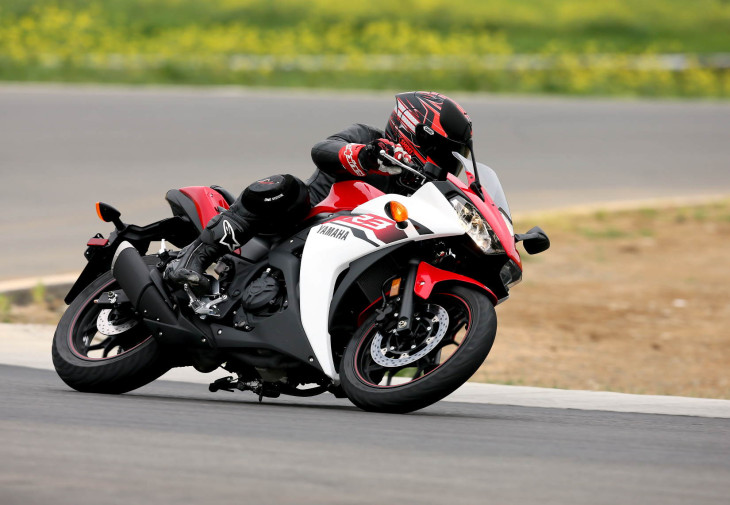

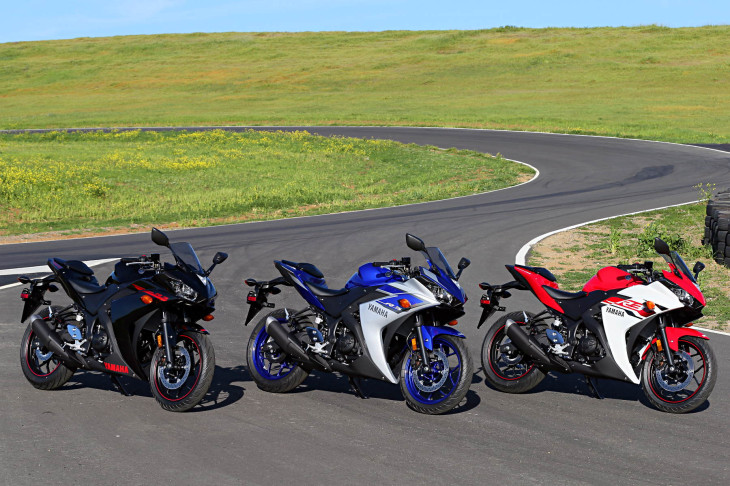

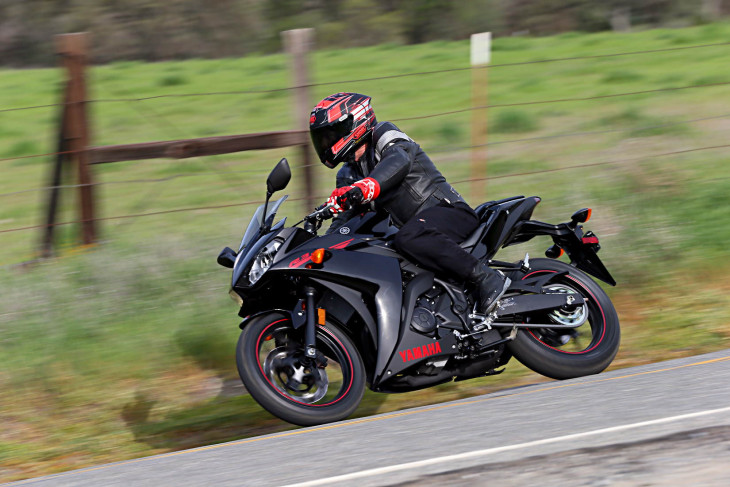

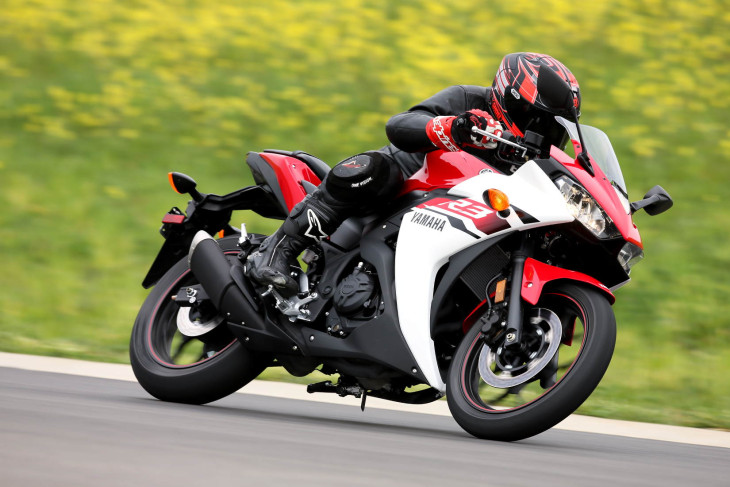
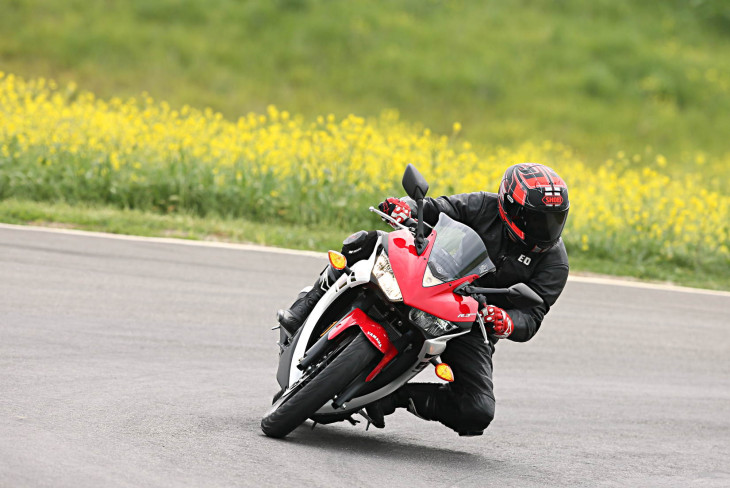

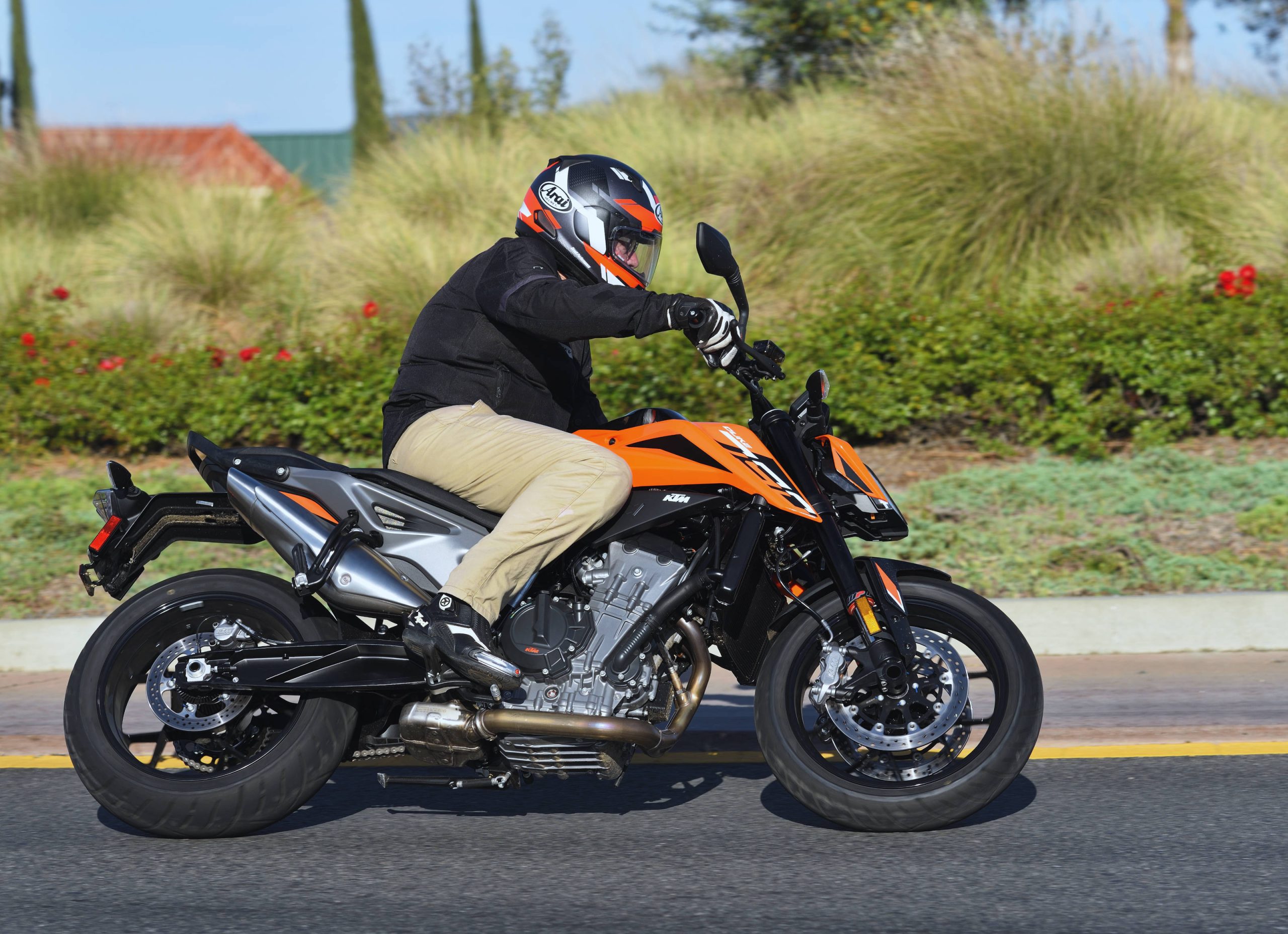
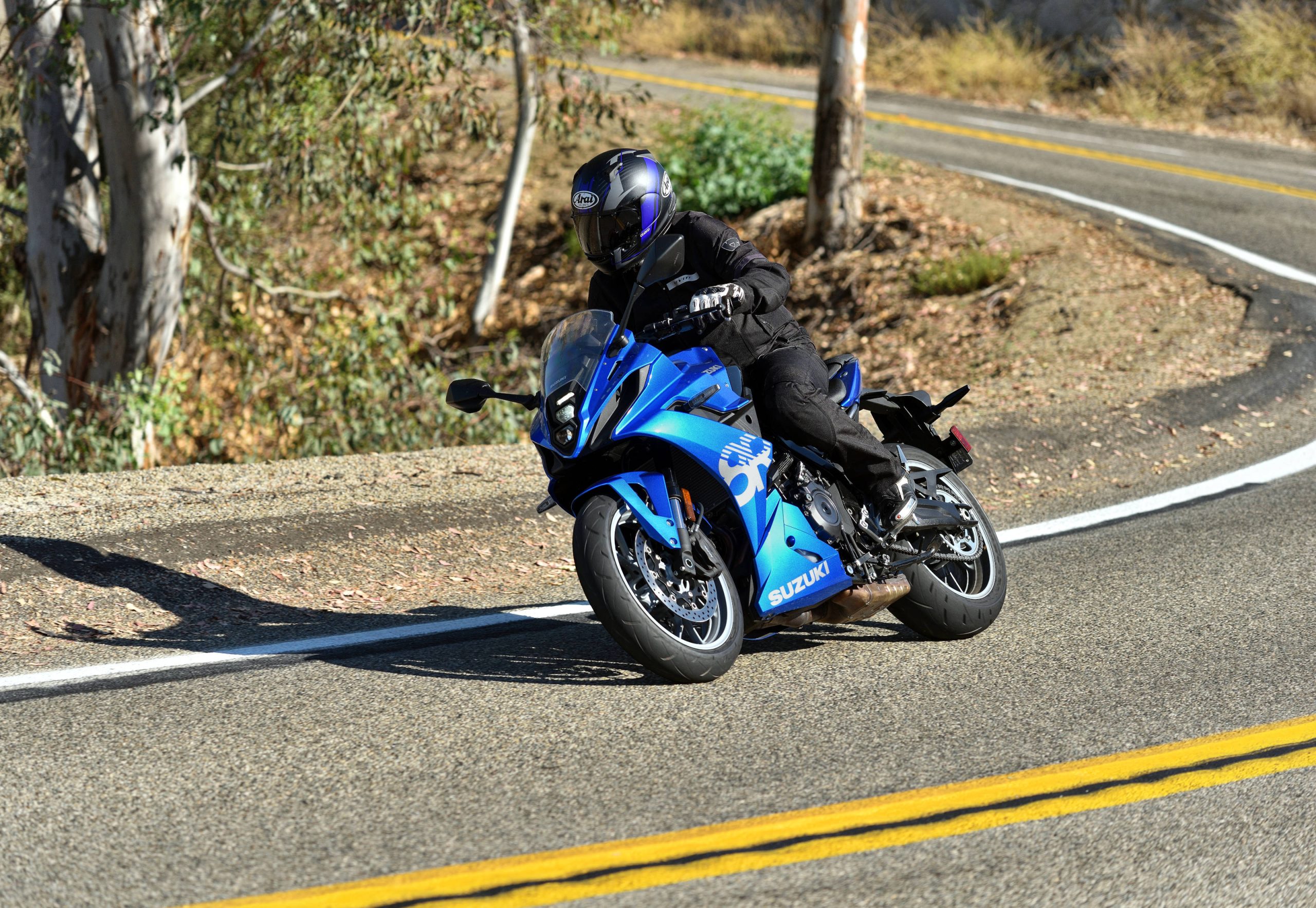
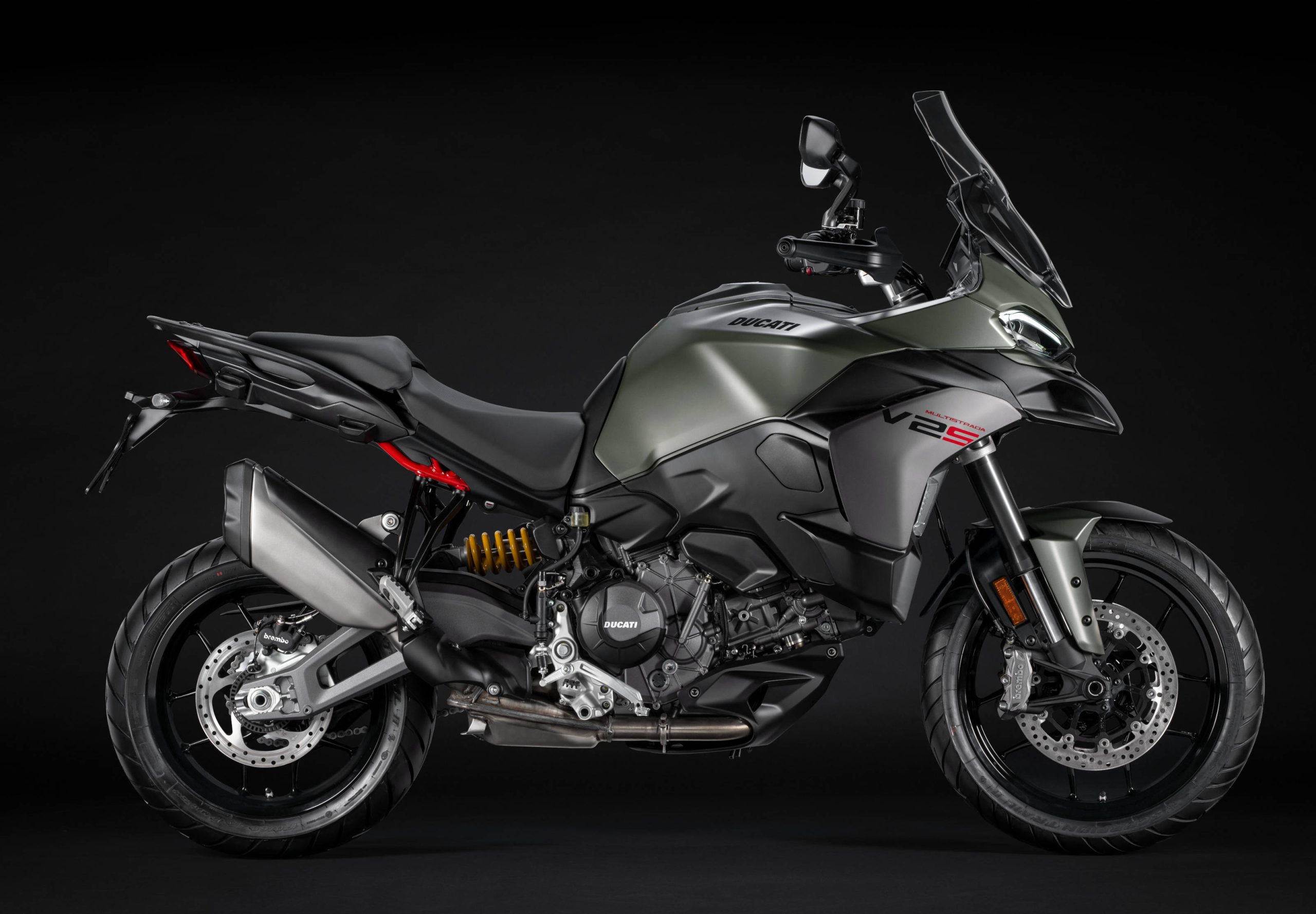
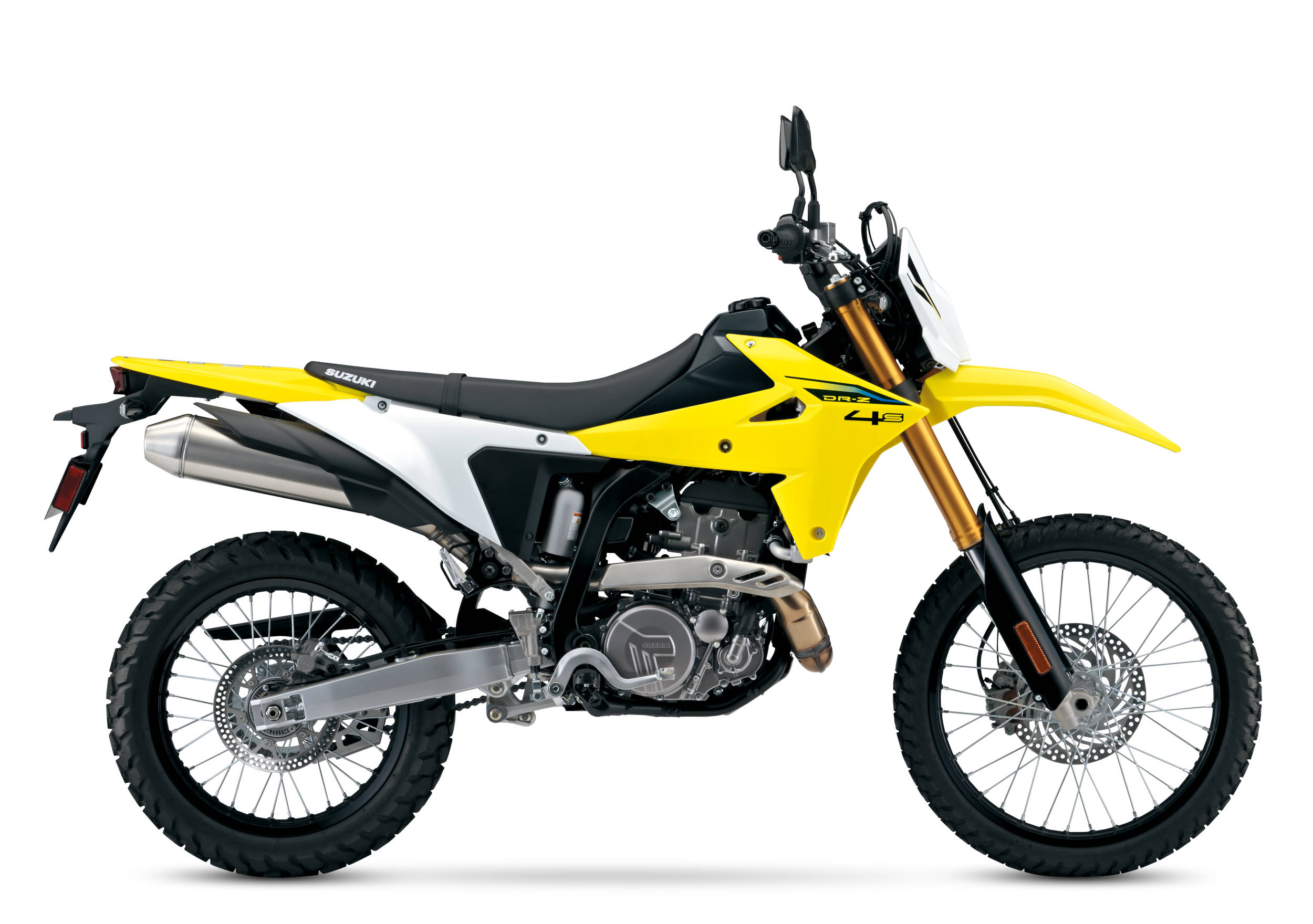
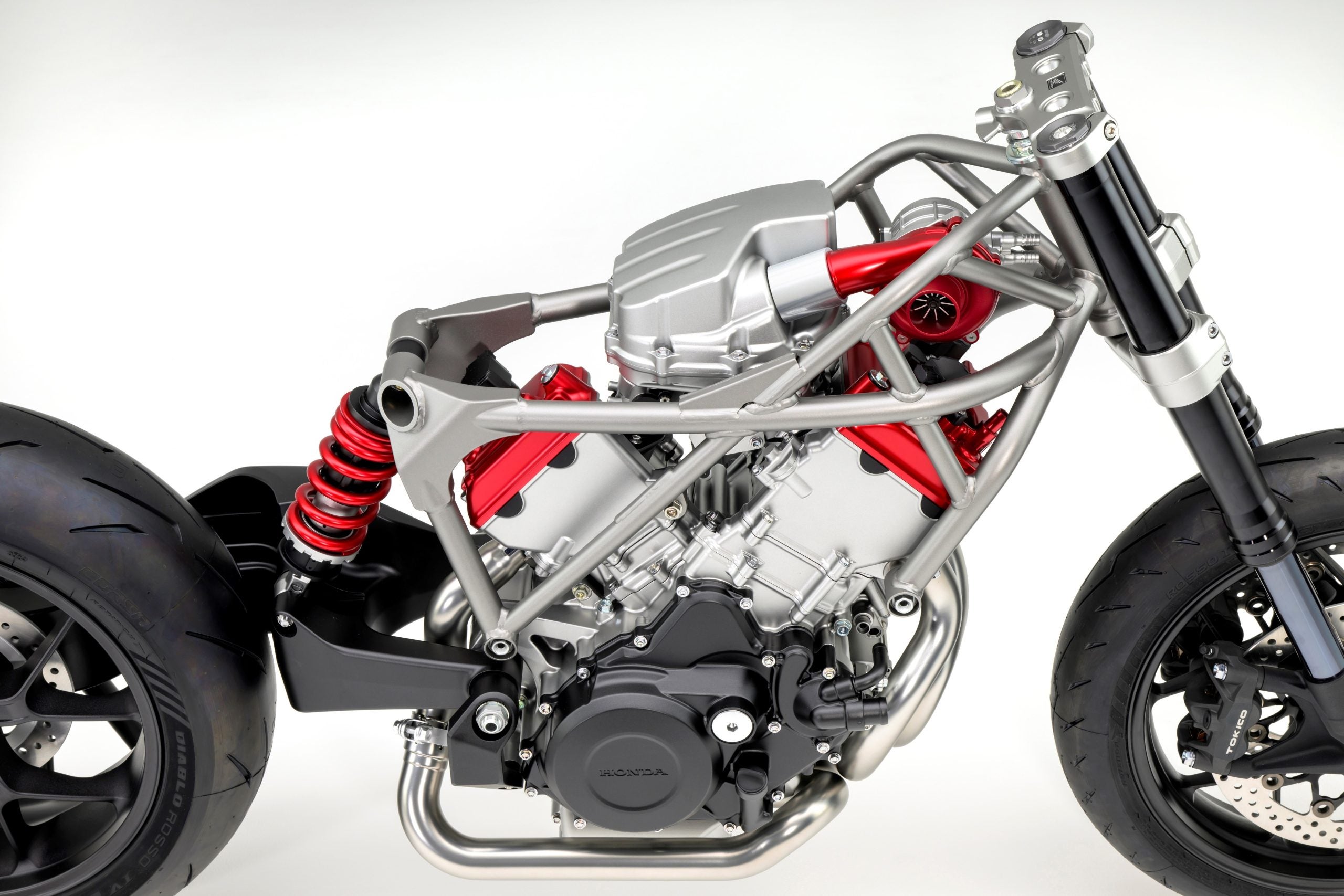
apart from the ‘bread-and-butter’/’play-it-safe’-sportbike
styling, this seems as the best-value bike in this category.
what troubles me, though, is that the 300cc category itself,
is becoming highly questionable value-wise.
it would be a completely different story to have a 3,700-4,000 USD
250-cc category over again.
again, a clear example of product development leading to
a loss of ‘category appeal’ (and a subsequent ‘product cannibalization’).
if you shed out 5 grand, you’d be WAY better to add a couple
of hundreds and go for a 500cc/lightw.600cc naked bike instead.
(unless you’re really hooked on skinny, light(ish), frenetic-revving
little bikes).
Al Pinaweiss
Anyone in the motorcycle world ride the RC390 and R3 yet?
Thanks to Ed for interacting and answering questions!
Thank you too.
This is a very nice little bike but the more I think about it why not buy a lightly used Suzuki SV650 for half the price? A very proven platform and lots to pick from.
Some people just don’t buy used bikes.
Because 300 != 650
” Damping is soft for a smooth ride on the street, but the forks run out of travel when hard on the brakes at the track. ”
Just when you need them they fail you! Serious flaw that will get new riders into trouble.
“Serious flaw that will get new riders into trouble.”
New riders don’t run out of fork travel while hard on the brakes. They either tuck the front or endo. And that flaw can only be remedied through practice drills or ABS.
re: “New riders don’t run out of fork travel while hard on the brakes. They either tuck the front or endo.”
touché.
or any situation thats an emergency. When you need them most the forks are letting down the braking. Just a crap situation brought about by muddy thinking.
I hear your point but everyone wants affordable starter bikes yet they want ABS, Ohlins suspension, adjustability etc etc. Maybe the rise of the America dollar will bring prices down enough for manufactures to add these things and keep prices low??? I don’t know how we older riders survived all those years without ABS and all the electronic gadgets now standard on so many bikes.
I think the situation is brought on by economics and compromise, not “muddy thinking”. I would want premium suspension performance from this bike as well. And if I had one of these, I would pay to improve the suspension. Most people would not – which is why the fork doesn’t perform like the one on the R1 and Yamaha isn’t demanding payment up front for such performance. It is sound thinking in my opinion.
I regularly do braking drills, and I fully compressed the stock suspension on most of the bikes I’ve owned while doing so – even the nice, fully adjustable units on one of my current rides. Anyone with the skill to remain upright during a braking incident that fully compresses the front fork can still handle the bike when the fork runs out of travel. If not, his/her date with the pavement was confirmed before the fork ever met the stops.
Most new riders don’t get the braking right in an emergency, which really is the bigger issue.
Yes, better forks are good.
No, they won’t help a new rider who ‘grabs a fist-full’ of brake without letting the suspension settle.
Most important IMO is helping new riders feel comfortable, then getting to confident so they can react without panic.
At race speed you will use all the fork travel by braking hard on any bike/fork. The point here is the balance between street and track riding has been met. This bike is stable on the brakes even with the forks bottomed.
So when will Honda come out with a 350 twin?
1968.
LOL!
Bravo, Sir!
I envy the young starting motorcyclists of today. When I started riding as a freshman in college back in 1997, sportbikes didn’t look like this. I started with the 1997 Ninja 500 and was never really a fan of the look since it didn’t look like it’s bigger brothers.
Now little 250’s and 300’s look as sharp and share some of the upgraded tech from the big boys which is so cool.
Personally I think young starting motorcyclists are hard done by today. In the late 80’s and early 90’s there was a huge range of ‘starter’ motorcycles to choose from. Many of them such as the 2 stroke twins and four cylinder 4’s (GSXR250, CBR250, RGV250, NSR, TZR etc etc) would also quite happily keep experienced riders entertained unlike the current crop of ‘learner’ motorcycles. What you now have are heavier learner bikes making less power and more importantly less ‘excitement’.
It doesn’t have a slipper clutch, or does it?
No slipper. It down shifts nice and easy.
The release of the R3, with its leapfrogging of the Kwacker and the Honda is a great Economics lesson for the uninitiaited youngsters who have been subjected to a Liberal-Slanted education at the hands of today’s educators. (Not all, but surely most) Government is the “LEAST” responsive to the consumer because they don’t have to be.
The Free Market allows for unfettered competition, which drives advancement and improvement of products. The consumer is the winner as K & H will now be forced to innovate once again or be left as the clear second and third choices.
IMHO, (of course) the Yamaha is the best looking too.
The market would gobble up a GSX-R400, I think… Innovate!
“…the uninitiaited youngsters who have been subjected to a Liberal-Slanted education at the hands of today’s educators. (Not all, but surely most) Government is the “LEAST” responsive to the consumer because they don’t have to be.”
Politics and economics from a motorcycle test.
Tom, the best way to teach a principle is to draw from real world scenarios that interest the pupil.
So yes
We’ve seen this movie. It results in $12k 600cc SS bikes that kill newbies and 20 year old smaller bike alternatives.
There is no such thing as a free market in a country with government representatives appointed by said market.
you’re off on a tangent…we are talking about the 250 class that became the 300 class.
Innovation is what it is.
The flip side is for those who don’t want or need the best bike in the category, older tech usually comes at a discount.
Re:”you’re off on a tangent…we are talking about the 250 class that became the 300 class.”
How so? I’m describing what already happened once. Aside from really good 600’s, there was nothing innovative about it.
The 250 class has become the 300 class. Great. Now it’s becoming the 321 class and you can bet before long, it’ll become the 365 or 400 class, and so on and so on, until we don’t have good small bikes being imported. Again.
and then some one will make another 250 and it starts all over again.
Get over it.
600cc race replicas were developed to win races by the way,
and many manufacturers are making sensible realistic middle-weight bikes. So if you are disgusted with the 600cc race bikes, DON’T BUY ONE.
Lol, random post of the day. Coulda used some free market competition back in 2005 when the only options in the beginner bike category were 20 year-old designs from Kawi and Suzuki. Glad the manus are finally paying attention to this very important segment.
Them darned pesky Liberals, we need to go back to 2007 and we wouldn’t have all these great choices.
It’s rather common to see people rate bikes good, better, best according to horsepower development. It was common back in the day and you hear it today. Following that it’s also rather common to rate bikes by the number of cylinders they possess. My point being that they all have virtues that riders need to evaluate. Singles tend to not produce quite as much peak HP but also tend to be lighter and possibly develop a bit better torque down low. All else being equal they should cost a little less.
The big issue I see is the fudging of the displacement categories, presumably to get an engine performance leg up on the competition. Where does it end? At what displacement does it enter into the next displacement category? That’s the traditional view. Maybe there shouldn’t be displacement categories at all? What about categorizing bikes more toward their cost, physical size, engine be damned. For X amount of money Brand X is offering this bike, in a certain size, etc., etc. Cars are rather sold that way. That way there’d be no displacement constraints. A brand could stuff any engine size they wanted but go too big and costs could go up along with weight. Go too small and their performance compared to others in the price range would be off but they may be more thrifty?
Isn’t the fudging of displacement categories what had all the bikes getting bigger and bigger and bigger? Isn’t that what eventually came to offer fewer true beginner bikes like in the past?
On the other hand, maybe bikes just don’t follow other conventions? 🙂
“What about categorizing bikes more toward their cost, physical size, engine be damned.”
I think that is exactly what manufacturers are doing. They are not “fudging” a displacement category, they are introducing what they believe to be a competitive bike into a market segment, engines be damned. There is no such thing as a displacement category anymore except where racing rules influence design parameters, and even that is starting to breakdown with 636cc ZX6Rs and 1299cc Panigales being offered up.
You know, I guess I hadn’t thought this through enough? Perhaps because it’s still relatively common to include engine displacement in a bike’s name, something autos don’t generally do. But I think you’re right, dish up what they may is the order of the day!
I sure hope this doesn’t go the way it did before with a dearth of bikes below 600cc and that being thought of as being a beginner category. Smaller bikes can be and are a hoot and just the thing to sink the hook on new riders.
I am hoping this is a new beginning for small displacement bikes. Bikes like the Ninja 300 and R3 are very usable in all riding situations in the US. (I don’t care what anyone says – that was not true of the 250cc bikes.) I wasn’t willing to buy a 250 Ninja or Nighthawk when I started riding. A Ninja 300, R3 or RC390 would have been a completely different story. I hope they find their place.
re: “The big issue I see is the fudging of the displacement categories, presumably to get an engine performance leg up on the competition.”
Q: Where does it end?
A: where tiered licensing and the bureaucrat with a hard-on for motorcyclists begins.
You mention that a 5′ 6″ jockey fits on this bike well… what about a 6′ Neanderthal?
Great write up and yes, a great bike for sure… a good pipe and some suspension and it’s all the BIZ!!!
There was a 6 foot tall Neanderthal leading the street ride and going fast on the track too. He looked fine on the bike.
So not like the proverbial monkey/football situation? I’m 6’2″ and my (1st-gen) Ninja 250 looked like a 7/8 scale bike with me on it (even though I felt fine).
I thought it was a monkey/coconut. I had that Ninja too. The R-3 fits most people.
Ha, always have heard “football” but “coconut” is better :). Will bear in mind!
41mm forks means fully adjustable cartridge retrofit is easy. It’s been done for SV650, ninja 650, Bandit 400 etc. all with 41mm forks. It’s a shame none of the manufacturers don’t just spec 10 year old 20mm cartridge guts to go into their forks. Even if you don’t get adjustable (slow) compression (not really important) it’s such a HUGE win over damper rod crap.
Big cost difference and they would have to spend a lot more on the shock to match a cartridge fork so big cost difference x2.
define ‘big’. It can’t be more than $300 for the forks, and maybe another $200 for the shock. I’m not saying put Ohlins on the bike, just the same stuff they put on the YZF600R (thundercat).
Aftermarket fork cartridge kits are about $1200 retail, they have all the same parts as OEM so the cost to make them is a fair comparison. A damper rod is a tube with a few holes in it. A cartridge is a tube with a rod that moves in and out, one or two pistons to hold the shim stacks and slow speed damping adjusters.
And cartridge emulator kits are a lot cheaper than that, and work pretty well.
Traxxion makes their in small volume – hence $1200 per. Showa/Kayaba make them in a tens of thousands and fundamentally the main parts of a 20mm cartridge system hasn’t changed in 20 years so the tooling has been paid for upteen times over. The incremental cost is I expect a few hundred dollars, tops.
I do cartridge retrofits for SV, 650R, FZ/MT07 for 1/3rd Traxxion’s price. But I recycle Showa parts.
But hey, they have to leave some meat on the bone for profit and of course we’d all be outraged if they asking $6K for the bike with the better legs. The standard suspension offers a profit opportunity for dealers and aftermarket vendors. They have mouths to feed too.
re: “The standard suspension offers a profit opportunity for dealers and aftermarket vendors. They have mouths to feed too.”
in the words of Mr. Herlihy…
https://www.youtube.com/watch?v=p_v9RUE2nrw
January, 1985 issue of Cycle World is interesting read from 30 years ago. Explanation of different engine configurations, pipe test on RZ350(42HP @9K, 30ft.lb.@7K), and way more information than what you see in that same publication these days.
The R3 should dyno in the 35-36rwhp range. Should be a useful amount. The ’73 RD350 did about 33.
ww.champsclock.com/50cc/yam-rz350-spec.jpg
Sounds like a really nice little bike with a sweet engine. Yamaha HAS been on a roll with well designed yet affordable rides. Wonder if/when they’ll extend the platform ala Honda and provide standard and/or ‘adventure’ versions. Something more upright would make an awesome urban assault weapon.
I’m really gonna have to try some of these little guys out. I still don’t think I’m gonna like a single, but I’m gonna have to give ’em a try. Too bad nobody’s doing a vtwin, but at least Yamaha and Kawi are fighting the good fight. I really wish KTM did theirs as a twin. I’m so glad that they’re all within 500 dollars of each other (excepting Honda). It’s gonna be a good year to get people on sport bikes.
“I still don’t think I’m gonna like a single”
You won’t have to like a single:
” This fuel injected, parallel twin means business.”
Just saying…
You really want a VTwin? Here ya go! http://www.sntmotorsusa.com/new_product/introduction.asp?Cat=RoadSports&model=GT250R&year=2015
The bigger front forks will be a no brainer for suspension upgrades, and Yamaha smartly chose a twin: Despite Honda’s tremendous resources, singles shake, and removed the CB300 from consideration for me.
But the real no-brainer is that Yamaha may have hit that sweet spot: 250-class weight and economy, but just enough extra horsepower + 6-speed transmission so you really can travel Interstate. Brilliant. For a commuter bike for those of us that want a real motorcycle instead of a scooter, this class of motorcycle has never had as many good choices as it does now.
Just to add an obligatory ‘why no ABS on learners bike in 2015?’
I mean this bike will primarily appeal to begginer riders so why not just offer it as an option? It’s on the European bikes ffs….
Good question, but why is there not ABS on *all” current production bikes?
I know that there are people who like to claim that they have the skill and reflexes to outperform a computer’s millisecond-class brake modulation as their wheels traverse sand, oil, dirt, water, loose gravel, and whatever else has spilled out onto the road, but that’s not reality. As Jay Jackson, Executive Director, ABATE of Indiana, and MSF Certified RiderCoach Trainer said “As much as I’d like to believe that I could, I don’t think that I could stop in a shorter distance on any surface without ABS.”
“but why is there not ABS on *all” current production bikes?”
I suppose the answer is two-part:
1) There is no US law requiring ABS for motorcycles
2) The number of people in this market segment willing to shell out the extra $ for ABS isn’t sufficient enough and the number of buyers willing to buy the bike despite the lack of ABS is materially unchanged to justify the expense of having two different inventories of otherwise the same model.
Part two is just speculation, but I can’t think of any other reason. They’ll study the sales data, I’m sure, we’ll see an ABS model if Yamaha determine that they are losing sales to Honda and Kawasaki due to ABS.
Yamaha website don’t post as many pron photos about the motorcycle details as they previously did.
Seems like Yamaha keep scoring on all the games, hopefully with the offers being matched soon by Honda and the others.
Review mention the quality of the brakes, I tough I was going to see the Yamaha trademark caliper but it seems like a standard Nissin one.
Does anyone knows about the story of their trademark calipers? (from my quick view on the R6, FZ9, FZ7)?
Yamaha trademark caliper?
You mean the 4-piston, monoblock calipers first seen on the 1997 YZF-600R and YZF-1000R (which, back then, had the blue-colored piston bore plugs with the star-shaped cutout)?
Last I knew, those calipers were made by Sumitomo.
They are excellent, but I would be pleasantly surprised if Yamaha Motor Co. had specified those for the YZF-R3 due to cost, more than anything.
The caliper it does come with looks like a typical 2-piston slide pin jobbie.
those ones, thanks for all the info!
Seems like Sumitomo it’s one of those big companies, doing anything and everything down to insurance.
Interestingly it’s also a main stake holder at Mazda.
re: “Does anyone knows about the story of their trademark calipers? (from my quick view on the R6, FZ9, FZ7)?”
I believe the company is ADVICS. they’re a Japanese supplier on car side of brake components to Toyota hence the connection to Yammy.
Toyota and Yamaha have long been bedfellows.
12,500 rpm is pretty high for a parallel twin’s redline…the old 1988-1990 FZR 400 4 cylinder had a 14,000 rpm redline.
Sounds like a fun track bike with the right tires/ suspension. I can’t wait to see a shootout between this and the KTM RC390.
I had a 1991 Ninjja 250R that had a 14k redline.
This new R3 is over-square enough that it could have a much higher redline. 16k maybe?
Could? Running an engine up that high to make even greater horsepower will most surely sacrifice torque down low in the rev range, something this class does not have an abundance of.
No one is forcing anyone to keep the revs “way down.” Why is this such a concern for some people? If you’re putting around, a great abundance of torque does not matter. When you want to race around, keep the revs up higher where the engine is more powerful. Easy peasy.
It’s a different kind of power. ;-P
Seriously though, Torque at lower rpm is just more comfortable to ride at less than 8/10th’s pace. This bike also sounds like it’s far less stressed at our US highway speeds.
Or if you don’t want to row up and down through the gears constantly just to keep the kettle on the boil. You’re right, no one is forcing you, except traffic situations which slow you quickly thus finding you several gears too high, needing a number of gear changes before the peaky engine wants to come alive.That’s where having more down low becomes a great asset and could even save your bacon in some circumstances..
Oh, ok. I’ve never had that problem since I automatically down shift while slowing down. I don’t wait until I’m stopped to select the right gear. It’s a good skill to learn so you can rocket away at any speed.
I do that too Todd as a general rule but I have been in some situations where slowing was the first order. Take for example booking it into a tight corner at speed only to find a decreasing radius or off-camber turn. A first reaction is to clamp on the binders (may not be the best?) and in mid-turn you find yourself in a too tall of gear and must then row down through the gears before the engine takes commands and you can power on out.
Another example, back in the day I rode a bike with a relatively wide powerband compared to competing two-strokes. There was a 1/4 mile long hill close to us that had a 40 mph limit. I could climb the hill and actually increase my speed slightly in top gear while the two-strokes with much narrower powerbands needed two downshifts in order to make the grade. OK, you may think big deal, what’s two shifts down, you do what you gotta do! But in a day’s ride that’s a lot of extra rowing up and down. When you’re used to being able to simply apply some throttle you come to appreciate that.
In regards to this thread, pushing the rpm ceiling even higher in pursuit of greater power still will most certainly take away from down below. More power to you if you like rowing a gear lever constantly, I sure don’t.
The R3 has a longer stroke than the Ninja 250. It doesn’t make sense to think it would rev higher than the Ninja. The rpms you are suggesting would result in some pretty serious MPS.
I’d guess the Yamaha likely can rev a bit higher but would make less power due to its state of tune. If that is the case, it would make sense to cap the redline to improve reliability.
The bore to stroke ratio is a better indicator of rpm potential. If you look at that, then it would makes sense to think that the R3 could rev higher than the Ninja 250. The Ninja 300 has a longer stroke than the R3, yet it revs higher.
“The bore to stroke ratio is a better indicator of rpm potential. ”
There are lots of variables that determine max rpm, but the bore:stroke ratio is not one of them. I know of an engine with a bore to stroke ratio of 1.1 that redlines at 39,000 rpms. A Triumph Bonneville has a ratio of 1.32 and can’t rev past 8000 rpms though by your rule of thumb should rev higher than a Ninja 300 with a 1.27 ratio.
Stroke certainly isn’t the only deciding factor either with regards to rpm potential, but it is a much better indicator of rpm potential than the bore:stroke ratio as that is what determines mean piston speed.
Yes. There are a lot of variables. I didn’t realize that I had to list every one of them. Not sure how you made the jump from Ninja 250/300 and R3 to a Nitro RC engine and air cooled cruiser engine either. Apples to tofu to oranges. ?? I suppose to make a point, you had to reach.
A quick google found an engine with a 1.15:1 ratio that revs to 43,000 rpm. More over square and a higher rev limit. Go figure… Not sure what a Nitro RC engine has to go with motorcycles anyway…
If I were going to compare air cooled engines, I’d compare the Bonnie’s to a Moto Guzi v7. Any guess as to which engine is more over square AND revs higher?
Stroke a better indicator? All the motorcycle mfgs must have it wrong then as they go to bigger bores and shorter strokes for more RPM and more power for their respective sport bikes…
I’ll make my point simple then: All other things equal, more stroke = lower rpm capability. It just comes down to simple math. The ratio between the bore and the stroke have nothing to do with it (save for the increasing mass of the piston as bore increases, which also demands a lower rpm holding other things equal.)
My ’08 dos fitty Ninja is all done at 11K power wise, it will putt around town in high gear even though I am running +2 teeth on the drive sprocket. It has good power up to about 5K and then flattens, picks up again at about 8K. Think all of this is more a function of cam timing and pipe design more than engine stroke.
I think they would have hit it out of the park if they used a 3 cylinder engine
Probably would have hit it out of the price park, too.
No doubt the triple is an exciting proposition…
Yet, the weight goes up each time from a single to a twin to a triple…
This would make a fine addition to my garage! What’s not to like about it? Although it is higher-priced than the Honda, I think you’re getting your moneys worth for the extra $1000.
I totally agree. I bought a CB 300F for Christmas and am nearing 2k mi on it. At age 72 it has all the performance I need, but I usually do my 42 mi each way commute at only 70-75 mph and the winding road ability gives me all the fun I need.My other bike is an XB9SX Buell. If I were 20 years younger the Yamaha for another 1k might be a must.
“We found the LED speed readout”
You mean, LCD?
All the best,
Aaron Lephart
The thing that makes the numbers is easy to read. 😉 Good catch.
Hard to believe 1978-1980 Suzuki GS1000 (the then-best handling Japanese liter bike, about 540 lbs curb weight) fork diameter was 37mm, the biggest of the liter bikes of that era. This bike with estimate 55% of the GS’ power and 170 lbs lighter has 4mm larger diameter fork sliders. Crazy!
Yes, and for years, 43mm was considered huge and mega-beefy.
I got 43 mm forks on my 250…
After having many sportbikes all the way up to zx14 moved to a touring bike. Great for touring but barge around town. This brings back memories of Yamaha RZ350 days, its going to be between the R3 and KTM RC390. Can’t wait for small bike shoot out!!
Looks good for small bike lovers this year. Did they crank the one with the Yoshimura pipe?
They did. It’s a street legal CAT back system. I think Rich Oliver was out on it but I did not hear it, I was busy riding till the flag came out.
Nice bike, now just put a two stroke motor in it and we are really talking… I miss my old RD.
Great looking bike the big boys look a mess in comparison.
Looks like a winner. Best small bike @ US highway speeds and doesn’t seem to give anything up to the Honda or Kawasaki in other areas.
I wonder why Yamaha “notches” their fairing between the windscreen and the sides (see behind mirror perches)? Seems like that loses a significant amount of wind protection.
so you can turn the handlebars farther.
The race replicas have that notch for clearance with the clip-ons. If the R3 is anything like my Fazer 8, the notches are a styling exercise because the bars never get near them. In my case I wish they weren’t there, but there’s not much to be done for it short of throwing on a huge honking Givi replacement windscreen which I’d have to order direct from Europe.
“doesn’t seem to give anything up to the Honda or Kawasaki” The Honda is a fair bit cheaper.
About $600. Less if you add ABS to the Honda.
And the Honda will surely deliver better fuel economy. But this R3 would be my pick. Yamaha seems to be hitting all the right buttons lately.